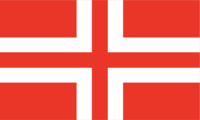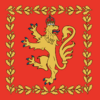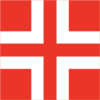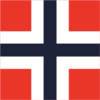Flag of Great Nortend: Difference between revisions
(→Use) |
No edit summary |
||
| Line 12: | Line 12: | ||
| Designer = Sir Almandy Fleurin, Lamanus King of Arms | | Designer = Sir Almandy Fleurin, Lamanus King of Arms | ||
}} | }} | ||
The '''national flag of [[Great Nortend]]''' is, by proclamation, a rectangular flag known as the '''Great Cross of the Realm'''. Its design includes the Arms of St Christopher, the patron saint of the province of Hambria with the Cross of St George, one of the two patron saints of the province of Nortend, superimposed on top. This consists of a red field with a centred broad white cross reaching to the edges, with a narrower red cross also reaching to the edges above. An often-seen variant has a dark blue cross instead of a red cross. This is known as the '''War Cross''' and is used as the flag of the [[HM War Office ( | The '''national flag of [[Great Nortend]]''' is, by proclamation, a rectangular flag known as the '''Great Cross of the Realm'''. Its design includes the Arms of St Christopher, the patron saint of the province of Hambria with the Cross of St George, one of the two patron saints of the province of Nortend, superimposed on top. This consists of a red field with a centred broad white cross reaching to the edges, with a narrower red cross also reaching to the edges above. An often-seen variant has a dark blue cross instead of a red cross. This is known as the '''War Cross''' and is used as the flag of the [[HM War Office (Great Nortend)|armed forces]]. | ||
The design of the Great Cross was first used officially during the reign of Alexander I, as the first King of Nortend, Cardoby and Hambria as part of the insignia of the Alexanderine Service Order. It was later adopted in 1870 by Henry VI. | The design of the Great Cross was first used officially during the reign of Alexander I, as the first King of Nortend, Cardoby and Hambria as part of the insignia of the Alexanderine Service Order. It was later adopted in 1870 by Henry VI. | ||
Revision as of 05:56, 8 October 2020
 | |
| Name | Great Cross of the Realm |
|---|---|
| Use | National flag |
| Proportion | 2:3 |
| Adopted | 1 April, 1870 |
| Design | A red cross on a white cross on a red field. |
| Designed by | Sir Almandy Fleurin, Lamanus King of Arms |
The national flag of Great Nortend is, by proclamation, a rectangular flag known as the Great Cross of the Realm. Its design includes the Arms of St Christopher, the patron saint of the province of Hambria with the Cross of St George, one of the two patron saints of the province of Nortend, superimposed on top. This consists of a red field with a centred broad white cross reaching to the edges, with a narrower red cross also reaching to the edges above. An often-seen variant has a dark blue cross instead of a red cross. This is known as the War Cross and is used as the flag of the armed forces.
The design of the Great Cross was first used officially during the reign of Alexander I, as the first King of Nortend, Cardoby and Hambria as part of the insignia of the Alexanderine Service Order. It was later adopted in 1870 by Henry VI.
Protocol
The Great Cross and War Cross are highly distinctive symbols of Great Nortend. By an order of the Privy Council, the Great Cross must be flown at all manned government buildings or establishments, unless impracticable, and the War Cross at any military or naval establishments. For example, six Great Crosses and one War Cross are flown from the roofs of the main Government buildings at Fettercourt in Lendert-with-Cadell, as well as numerous on flagpoles along the facade. The highest flagpole is reserved, however, for the Royal Standard when it is flown instead.
Along with other heraldic and flag-like banners, standards and colours, it is often hung up, paraded and used more generally as a patriotic symbol by civilians and the armed forces. Notably, the annual King's Day celebrations on Whitsunday every year commonly involve parades of hundreds of Great Crosses and variations, along with Royal and local banners.
It is a felony to intentionally damage the Great Cross or War Cross.
Raising and lowering
The Great Cross and War Cross must generally be raised and lowered daily when flying from a flagpole. In the military and navy, this is usually accompanied by a fanfare or other musical call.
Generally it is the custom to roll the flag into a cylinder tied in the centre when not in use.
Mourning
The flag is flown at half mast on certain mourning days as well, including:
- From the death of the Sovereign until the formal Accession of the new sovereign.
- From the death of a member of the Royal Family until the day of his funeral.
- From the death of the Archbishop of Sulthey until the day of his funeral.
- On the death of the Archbishop of Limmes or of Rhise.
- On the death of the present or former Officer of State.
- On the death of a foreign Sovereign
When it is not possible to fly at half mast, owing to the flag being indoors and fixed or if its staff is too short, a black ribbon is tied at the top of the mast.
Other flags
| Flag | Name | Use |
|---|---|---|

|
Royal Banner | Heraldic banner of the Sovereign. |

|
Great Cross | Uses as the national flag. |

|
War Cross | Uses as the flag by the Royal Army and Navy Royal. |

|
Square Jack | Used as the civil maritime jack. |

|
War Jack | Used as the naval jack by the Navy Royal. |

|
Red Ensign | Used for civil purposes. |

|
Red War Ensign | Used for military purposes. |

|
Blue Ensign | Used for civil maritime purposes. |

|
Blue War Ensign | Used for naval purposes. |
All merchant vessels, commercial vessels, and pleasure craft registered in Great Nortend are required to fly the White Ensign at the stern during the daylight hours. Similarly, all aircraft registered in Great Nortend are required to fly the White Ensign from the cockpit during daylight hours when on the ground. Certain yacht clubs and flying clubs are entitled to fly a Blue Ensign, either defaced or undefaced. Some fly defaced White Ensigns or Red Ensigns. If flying anything other than the plain White Ensign, marinecraft must fly the corresponding burgee from the mainmast or jack to prove entitlement, and carry a warrant. No requirement to fly a burgee exists for aircraft, although the warrant must still be carried.
Vessels owned and operated by government ministries or departments such as those of Customs, the Post Office and the Trade Office fly a Blue Ensign defaced with a departmental badge. A plain Blue Ensign is flown by warranted harbourmasters and certain other officials. Similar flags are flown on land by government departments.
All Navy Royal vessels fly the Red Ensign at the stern, with the Square Cross as jack when moored or anchored.
